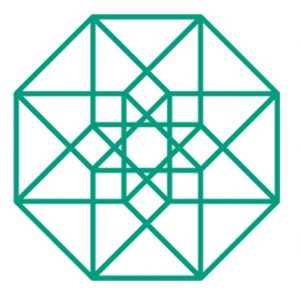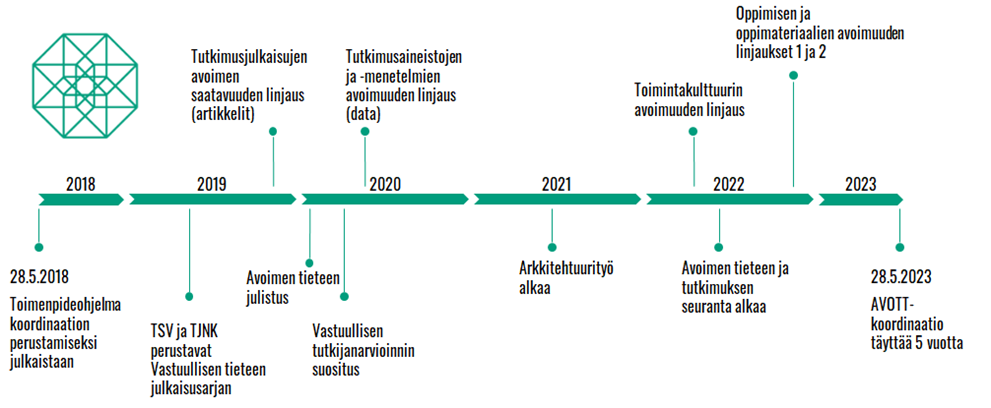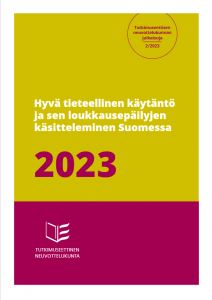The opening section of the Open science annual review 2023 focuses on the domestic policies in Finland and outputs of the national Open science and research (AVOTT) collaboration. In addition, we also looked at last year’s news and reading tips. The news sections highlights a new initiative by Plan S funders, which has been described as revolutionary, and topics such as the cost of open access publishing and research evaluation. The reading tips include reviews of the open access situation in China, data discoverability and description, and reputation management for scientific publishers, in particular MDPI. The second part of the Annual Open Science Review focuses on the main topic of the past year: the problematic present and possible futures of open access publishing.
(Tämä artikkeli on saatavissa myös suomeksi.)
Text: Juuso Ala-Kyyny and Mika Holopainen
This article summarises the key open science news for 2023 and offers reading recommendations. The annual review also provides an overview of open science activities in Finland, in particular the work done in the Open science and research (AVOTT) collaboration. The blog article includes the following sections:
National policies, recommendations and guidelines
Open science news x 10
- A new initiative by Plan S funders would overhaul the publishing system
- CoARA coalition to reform research assessment begins its work
- Latest figures on open access publishing prices
- An organisation’s APC tracking does not catch all payments
- Record number of research articles retracted
- Guidelines for responsible conduct of research revised
- FSD has been archiving qualitative research data for 20 years
- Data availability information found in one in four articles
- Report on the implementation of UNESCO’s open science policy published
- Citizen science featured in open science awards
The open science mid-year review also published the following news from early 2023 (links lead to another article and news are in Finnish):
- EU declaration paves the way for free of charge open access publishing
- Web of Science removes journals from its database, including two MDPI journals
- New eLife policy: all submissions for peer review will be published
- New copyright law eases data mining for research
- Twitter data becomes paywalled for researchers
- Editors of two Elsevier journals resign over APC fees
- Data organisation ABC workshop materials help get started with data management
- New OA Journals Toolkit for open access journals
- Report on copyright practices in scientific publishing published
- More support for the open access diamond model – Craft OA launched
Open science reading recommendations x 10
- How do researchers describe their data?
- How do researchers find open research data – and what obstacles do they face?
- China and open access: lack of national policy, cost concerns
- The rise of the open access movement through the eyes of contemporaries
- Where did the open access movement go wrong?
- Alternative publishing platforms not so alternative after all
- Report: The potential of repositories needs to be better realised
- The MDPI case – reputational damage and its consequences
- How do journalists make use of open access publications?
- Registering an OA journal in the DOAJ database? Lessons from Denmark
The open science mid-year review also published the following reading tips from early 2023 (links lead to another article and news are in Finnish):
- What does the future look like for transformative agreements?
- A proposal for a new culture of scientific publishing
- A series of articles on citizen science
- A little book on the philosophy of open science
- Shadow libraries and the citation advantage of open access publications
Year 2023 in domestic open science cooperation (AVOTT)
 During the first half of the year, the national Open science and research (AVOTT) published policies, recommendations and guidelines on research methods, teaching and research data, which are summarised in the mid-year review (in Finnish). AVOTT work has continued throughout the autumn on the following themes:
During the first half of the year, the national Open science and research (AVOTT) published policies, recommendations and guidelines on research methods, teaching and research data, which are summarised in the mid-year review (in Finnish). AVOTT work has continued throughout the autumn on the following themes:
- PUBLISHING: The policy on open access for theses was open for comments in the autumn. The AVOTT steering group aims to adopt the policy in early 2024.
- TEACHING: The recommendation on the accessibility of open learning environments and the quality recommendation on open learning and teaching practices were open for comments in the autumn.
- OPEN SCIENCE: In autumn, the AVOTT secretariat started planning the process of updating The declaration for open science and research and guidelines. The current open science declaration and the policies that have been implemented are valid for 2020–2025.
- OPEN SCIENCE: At its December meeting, the AVOTT steering group approved the document Reference architecture for open science and research 2024–2030 (Avoimen tieteen ja tutkimuksen viitearkkitehtuuri 2024–2030). Its official launch will take place at an event on 19 March 2024. The reference architecture provides an overview of the national target state for open science and research up to 2030, as well as an assessment of the current situation. The reference architecture has been developed on the initiative of the AVOTT steering group and the Ministry of education and culture. The preparatory work on the reference architecture was also featured in last year’s mid-term review (in Finnish).
In the context of national open science cooperation, a proposal to fund domestic scientific journals was also on the table last year and was open for comment last autumn. The proposal is being prepared by a working group of the Federation of Finnish Learned Societies (TSV).
Last year, AVOTT coordination reached the five-year milestone, which was celebrated with the Five years of open cooperation seminar in December. The article (in Finnish) published in Signum (4/2023) on the impact of the AVOTT guidelines in universities explores the practical consequences of the open science guidelines in organisations.

Open science news x 10
A new initiative by Plan S funders would overhaul the publishing system
 In October 2023, the CoAlition S of research funders published Towards responsible publishing, an initiative that goes beyond the original Plan S in its ambition. The initiative is based on the idea of a researcher-driven ecosystem of scholarly communication and publishing, where publishers are no longer referred to as publishers but as service providers. In addition to research publications, the proposal also provides for the open publication of non-peer-reviewed manuscripts (preprints) and peer-review reports. The new responsible publishing ecosystem is to be implemented gradually with the financial support of research funders, but it will also require a strong commitment from the research community, in particular from researchers. The draft proposal sets out a vision and principles for the future of scientific publishing – the draft was open for comments in the autumn and a new version is expected to be published in spring 2024.
In October 2023, the CoAlition S of research funders published Towards responsible publishing, an initiative that goes beyond the original Plan S in its ambition. The initiative is based on the idea of a researcher-driven ecosystem of scholarly communication and publishing, where publishers are no longer referred to as publishers but as service providers. In addition to research publications, the proposal also provides for the open publication of non-peer-reviewed manuscripts (preprints) and peer-review reports. The new responsible publishing ecosystem is to be implemented gradually with the financial support of research funders, but it will also require a strong commitment from the research community, in particular from researchers. The draft proposal sets out a vision and principles for the future of scientific publishing – the draft was open for comments in the autumn and a new version is expected to be published in spring 2024.
Our vision is a community-based scholarly communication system fit for open science in the 21st century. This system empowers scholars to share the full range of their research outputs and to participate in new quality control mechanisms and evaluation standards for these outputs. This approach will ensure rapid, transparent dissemination of high-quality scientific knowledge.
– Towards responsible publishing: a proposal from cOAlition S
- Read more: Open-access reformers launch next bold publishing plan (Nature, 31.10.2023)
- Read more: Ask the chefs: cOAlition S’s ”Towards responsible publishing” (Scholarly Kitchen, 16.11.2023)
CoARA coalition to reform research assessment begins its work
 The Coalition for Advancing Research Assessment (CoARA) set up ten working groups in 2023 to look at assessment from different perspectives. A proposal for a working group on multilingualism, put forward by the Federation of Finnish Learned Societies (TSV), is among the working groups set up. National chapters are also being set up within CoARA, and Finland is among the first 11 countries. The CoARA will implement the Agreement on Reforming Research Assessment, signed in 2022 by more than 600 organisations. More than 30 organisations from Finland are involved, including the University of Helsinki. Last year also saw the launch of the GraspOS project to build the infrastructure needed to reform research assessment.
The Coalition for Advancing Research Assessment (CoARA) set up ten working groups in 2023 to look at assessment from different perspectives. A proposal for a working group on multilingualism, put forward by the Federation of Finnish Learned Societies (TSV), is among the working groups set up. National chapters are also being set up within CoARA, and Finland is among the first 11 countries. The CoARA will implement the Agreement on Reforming Research Assessment, signed in 2022 by more than 600 organisations. More than 30 organisations from Finland are involved, including the University of Helsinki. Last year also saw the launch of the GraspOS project to build the infrastructure needed to reform research assessment.
- Read more: Increasing research diversity highlights the importance of responsible researcher evaluation (Think Open, 23.1.2024)
- Read more: The SCOPE framework – implementing the ideals of responsible research assessment (F1000Research)
Latest figures on open access publishing prices
Publication and price data for open access in 2022 are published in Walt Crawford’s annual compilation, Gold Open Access 2017–2022: Articles in Journals (GOA8). As its title suggests, the information package focuses on open access publishing channels (gold open access), which are either free of charge for authors (diamond open access) or paid for by the author. The analysis is based on data from the DOAJ database. Although the majority (67%) of OA journals are still free of charge, a growing proportion of articles (now 69%) appear in paid OA journals. The average price of an article processing charge (APC) per article was $1,310, down $64 from the previous year – this was the first time the price fell in the Crawford review.
- Read more: The oligopoly’s shift to open access: How the big five academic publishers profit from article processing charges (Quantitative Science Studies)
An organisation’s APC tracking does not catch all payments
An estimated half (48%) of article processing charges (APCs) paid by research organisations were not tracked by their own APC monitoring, according to a study published last year, Monitoring organisational Article Processing Charges (APCs) using external sources. The study by Anna-Kaarina Linna, Irene Ylönen and Anna Salmi looked at APC monitoring at the University of Turku in 2017–2018. APC monitoring is key to managing the costs of open access publishing and negotiating journal contracts with publishers. Since the time of the study, so-called transformative agreements have become more common, which has probably made APC tracking easier – although the APC fee burden has increased at the same time. A summary of the article (in Finnish) has been published on Avointiede.fi.
Read more: More transparency on open access pricing – University of Helsinki contributes to the OpenAPC service (Think Open, 27.11.2023)
Record number of research articles retracted
More than 10 000 research articles were withdrawn during 2023, according to a study by Nature. The study is based on data from the Retraction Watch and Dimensions databases. The report was published in December, so it does not include all articles retracted during last year. However, it is the largest number of retractions to date in the annual year-on-year comparison. The figure is explained by the exceptionally high proportion of retracted articles from Wiley-owned Hindawi journals – over 8,000 articles, the vast majority of which were published in so called special issues created by guest editors. Previous analyses suggest that the vast majority of articles retracted are related to deliberate misconduct, but articles are also retracted due to human errors.
- Read more: How big is science’s fake-paper problem? (Nature, 6.11.2023)
- Read more: Surge in number of ‘extremely productive’ authors concerns scientists (Nature, 11.12.2023)
- Read more: The ‘hijacking’ of the Scandinavian Journal of Information Systems: Implications for the information systems community (Information Systems Journal)
- Read more: Scientific retractions may become easier to spot as Retraction Watch finds new partner (Science, 12.9.2023)
- Read more: The Retraction Watch Database becomes completely open (Retraction Watch, 12.9.2023)
Guidelines for responsible conduct of research revised
 The update of the responsible conduct of research (RCR) guidelines, which started in 2020, was completed during 2023, and The Finnish code of conduct for research integrity and procedures for handling alleged violations of research integrity in Finland 2023 (pdf) was published in March. The guidelines by the Finnish National Board on Research Integrity (TENK) were first published in 1994 and have since been updated in 1998, 2002 and 2012. The guidelines are complemented by the Implementation checklist for the 2023 RI guidelines (pdf), which is aimed at researchers and organisations.
The update of the responsible conduct of research (RCR) guidelines, which started in 2020, was completed during 2023, and The Finnish code of conduct for research integrity and procedures for handling alleged violations of research integrity in Finland 2023 (pdf) was published in March. The guidelines by the Finnish National Board on Research Integrity (TENK) were first published in 1994 and have since been updated in 1998, 2002 and 2012. The guidelines are complemented by the Implementation checklist for the 2023 RI guidelines (pdf), which is aimed at researchers and organisations.
- Read more: Ethical guidelines for responsible academic partnerships with the Global South (UniPID)
- Lue myös: New research ethics journal launched – Research Integrity Practice in Europe (RIPE)
FSD has been archiving qualitative research data for 20 years
The first qualitative data deposit in the Finnish Social Science Data Archive (FSD) was made 20 years ago. A mini history (in Finnish) on the FSD’s website summarises the pioneering stages of data management and open research data. Along the way, research culture has undergone a major change and services for researchers have also evolved. The Penna tool for textual data collection, launched in 2017, now collects a third of the qualitative data in the FSD. There are more than 300 qualitative data sets in the repository and 1500 quantitative data sets. There are 130 fully open datasets, accessible through the Aila portal.
Data availability information found in one in four articles
About one in four research articles published by a researcher at the University of Tampere includes a Data Availability Statement (DAS), according to a review article published last year entitled Tutkimusdatan saatavuustiedot tieteellisissä artikkeleissa (Research data availability information in scientific articles). The survey by Tomi Toikko and Kaisa Kylmälä covered 2085 articles from 2020–2021, with DAS statements varying in format and location in the articles. Based on the statements, the data was stored in data repositories and as part of the article; the data was also held by the researcher. Where data were not shared, the reason – when reported – was often due to data sensitivity, legislation and ownership reasons. The study found that no DAS statements were found in any of the Finnish journals.
One of the key challenges of the survey was to define what is considered research data. Data is highly research and discipline specific, and so its form and quantity varies greatly from one study to another. In order to have a more detailed understanding of the research data associated with an article, one should have at least some understanding of the research in question.
– Toikko & Kylmälä: Tutkimusdatan saatavuustiedot tieteellisissä artikkeleissa
Report on the implementation of UNESCO’s open science policy published
In 2021, the UN education agency Unesco published its recommendations for open science. Last year, a follow-up report to the recommendations, Open science outlook 1: status and trends around the world, was completed, evaluating the state of open science worldwide. The report shows that progress has been made in open science practices, but progress has been uneven, reflecting differences in socio-economic and digitalisation developments across countries. With these differences, the benefits of openness are also unevenly distributed. The report draws attention to the need for interoperability and sustainability of open science infrastructures. The report also describes – in the ”Examples of open science in action” section – the Finnish coordination model for open science and research (AVOTT).
Citizen science featured in open science awards
The University of Helsinki’s Open science award was presented in October to the multidisciplinary Helsinki Urban Rat Project. In November, the rat study led by Tuomas Aivelo was also judged worthy of a national open science award. Another national open science award went to the Muuttolintujen kevät (Spring of migratory birds) application, which has been developed jointly by the University of Jyväskylä, the Finnish broadcasting company Yle and the CSC – IT Centre for Science. Aalto University also rewarded the promoters of open science. The top prize went to the Aalto Materials Database Initiative (AMAD), a project that uses open data for materials science research. Professor Riikka Puurunen and her catalysis research group were awarded an honorary mention, while the third prize was awarded to the team for robotic manipulation of deformable objects (Tran Nguyen Le, David Blanco-Mulero, Gokhan Alcan and Ville Kyrki).
- Read more: Una Europa published the Citizen Science Toolkit

Open science reading recommendations x 10
How do researchers describe their data?
In the spring of 2023, two workshops were organised in the context of the Open science and research (AVOTT) collaboration. In the workshops researchers shared how they describe their research data and experts from research organisations discussed how the description guidelines could be developed. A concise summary of the workshops (in Finnish) can be found on the Avointiede.fi website. Siiri Fuchs, a data management expert at the CSC – IT Centre for Science, has also prepared comprehensive notes on the contents of the workshops (links in the Avointiede.fi post above). Heli Hyytiäinen (University of Helsinki), a veterinarian, shared her own practices in creating a data management plan (DMP) – she also wrote a blog article (in Finnish) based on her presentation.
How do researchers find open research data – and what obstacles do they face?
Findability is one of the FAIR principles of open research data, and openly available data can be very difficult to use if the dataset is not found or if there is not enough information about the data available. A study published last year, What are researchers’ needs in data discovery? Analysis and ranking of a large-scale collection of crowdsourced use cases, investigated data discoverability in over 100 use cases between 2019 and 2020. It resulted in a set of requirements and recommendations for data discovery tools.
China and open access: lack of national policy, cost concerns
China publishes the most research articles in the world, but has not yet taken the same step as Europe or the US in terms of open access. In his blog article, Nicko Goncharoff highlights the Chinese research community’s views on the development of open access, including concerns about the rising costs and business model of publishing, the problems caused by the lack of a national OA policy, and the blacklists of OA journals that are used to select publication channels. Transformative journal agreements, which are common in the West, linking subscription fees and open access, are rare in China. Just over a third (35%) of Chinese research publications were open access in 2021, compared to a global average of 44%. Journal metrics also plays an important role in China, while in Europe at least the trend is towards qualitative assessment.
Read more: Open science in China: an open and closed case (Observations)
The rise of the open access movement through the eyes of contemporaries
As research organisations in European countries agonise over the cost of scientific publishing and try to promote open access without author fees (APCs) in Latin America, this free of charge OA, or diamond open access, has become established as a key form of publishing. The book We so loved Open Access, published last year, celebrates the Latin American focused SciELO (Scientific Electronic Library Online) collaboration, founded in 1997, and highlights the voices of the early open access pioneers of the 1990s from different countries.
But of greatest note to me sitting at my desk in the global west was SciELO’s refusal to play the western scholarly communication game. Not to chase impact factors or to priorities ‘prestige’ journals. Rather than attempt to engage on an unfair playing field, they created their own, which respected local traditions and built a solid, multi-national consortium that provided equity of access to publication routes as well as equity of access to the research.
– David C. Prosser (Research Libraries UK) kirjassa We so loved Open Access
Where did the open access movement go wrong?
Richard Poynder, one of the key figures in the open access movement in the 21st century, announced that he would no longer be involved in OA issues and said the whole OA movement had gone off the rails. Poynder vented his frustrations in an interview with Rick Anderson. Poynder’s multifaceted critique could perhaps be summed up as follows: the scientific community has irreversibly fallen into the pockets of the big publishers by pursuing openness at the expense of other principles that have been central for the OA movement: financial sustainability and equality for researchers. And while the promotion of openness has been increasingly placed in the hands of funders and research organisations, researchers – who were the initiators of the OA movement – have, according to Poynder, been sidelined. In the interview, he no longer suggests ways to remedy the situation. On his own blog, however, he has a message for those who remain to promote open access: ”please prove me wrong!”
But in light of researchers’ continued reluctance to make their works open access, universities and funders began to introduce increasingly bureaucratic rules, sanctions, and reporting tools to ensure compliance, and to manage the more complex billing arrangements that OA has introduced. So, what had been conceived as a bottom-up movement founded on principles of voluntarism morphed into a top-down system of command and control, and open access evolved into an oppressive bureaucratic process that has failed to address either the affordability or equity problems. And as the process, and the rules around that process, have become ever more complex and oppressive, researchers have tended to become alienated from open access.
– Richard Poynder in Scholarly Kitchen interview
Alternative publishing platforms not so alternative after all
In recent years, an increasing number of so-called alternative publishing platforms have been established, which may differ from traditional scientific journals, for example in terms of the publication process, publication outputs, evaluation or infrastructure. The Knowledge Exchange, which is developing a European infrastructure for open science, carried out a study last year on this topic, looking at platform solutions, disciplinary boundaries, publication types, publishing practices, governance structures and ownership of alternative publishing platforms. The study found that the majority of platforms were run by the scientific communities and most platforms were open to all disciplines. The activities of publishing platforms often matched the role of publishers in publishing research articles, books and conference proceedings. In fact, the study found that only a small number – less than 10 out of 45 – were characterised by a search for alternative approaches. Peer review is mentioned as one of the themes where innovations were found.
Report: The potential of repositories needs to be better realised
As open science becomes the starting point in Europe, research data mining and other digitally-enabled research methods will become possible in a new way. But this vision requires access to research results, and this is most sustainably ensured by a strong and fit-for-purpose network of open repositories. This is the main message of the report, Current state and future directions for open repositories in Europe, by the European open science and library communities (OpenAIRE, LIBER, COAR and SPARC Europe). However, achieving this goal will require actions, of which the report identifies the most important as strengthening the technical infrastructure of repositories, developing practices for metadata, preservation and usage statistics, and promoting the visibility of repositories in the scientific publishing ecosystem.
The MDPI case – reputational damage and its consequences
The Think Open blog’s mid-year review of open science (in Finnish) reported that Web of Science (WoS) removed more than 50 journals from its database early last year, including two MDPI journals. The International Journal of Environmental Research and Public Health (IJERPH) was MDPI’s largest journal before the WoS announcement, but by the summer its publication numbers had plummeted by as much as 88% – and the WoS decision affected demand for other MDPI journals. Christos Petrou discusses the culture of publishing in the light of the MDPI case. Petrou examines the importance of the WoS-linked impact factor (IF) for researchers, the reputational damage that publishers like MDPI cause to its individual journals (MDPI still has more than 200 journals in the WoS database) and the structure of reputational damage in scientific publishing in general. An interesting point of comparison in Petrou’s analysis is provided by Frontiers, which is based on a similar publishing model as MDPI. Petrou’s article was the most read article of 2023 on the Scholarly Kitchen blog.
Read more: Publication volume decreased in MDPI journals (Julkaisufoorumi.fi, 17.10.2023)
How do journalists make use of open access publications?

How much use is made of open access publications by journalists who act as intermediaries for research results? Answers to this question were sought in interviews published on the Think Open blog interviews (in Finnish), in which non-fiction writer and journalist Juha Kauppinen and journalist Petja Pelli from Helsingin Sanomat described their uses of scientific information. And the same question was also addressed in a review article published last year, Making science public: a review of journalists’ use of open access research, which explored the use of open access sources in science journalism and in particular the impact of the corona pandemic on the use of open access sources. The article suggests that little research has been done on journalists’ use of research data and that even when it is done, the focus is primarily elsewhere. However, the limited data available suggested that journalists’ use of open access sources may be influenced by an increased reliance on traditional criteria for assessing scientific quality, concerns about the reliability of open research findings and challenges in using research findings.
Registering an OA journal in the DOAJ database? Lessons from Denmark
The international curated database of open access journals, DOAJ (Directory of Open Access), brings together OA journals that meet the quality criteria for publication, regardless of the language in which they are published. The database gives journals visibility and usage in a number of ways and reinforces the reputation of participating journals as credible publishing channels. In Denmark, a project led by three university libraries was organised between 2021 and 2022 to index the country’s OA journals in the DOAJ database. An offer the journal couldn’t refuse summarises the experiences of the Danish project, in particular the challenges that journals faced in meeting the DOAJ criteria. Out of 58 journals considered to have DOAJ potential, only 15 were eventually indexed in DOAJ. The main problems encountered related in particular to copyright and open licensing practices and editorial practices.
Previous annual reviews of open science:
- Annual review 2022: Open science annual review 2022 – national guidelines in Finland, main themes and news
- Annual review 2021: The open science annual review 2021: key topics and news
- Annual review 2020: The open science annual review picks up the main topics in 2020: from Plan S to coronavirus pandemic
- Annual review 2019: The open science annual review summarizes the main topics for 2019
